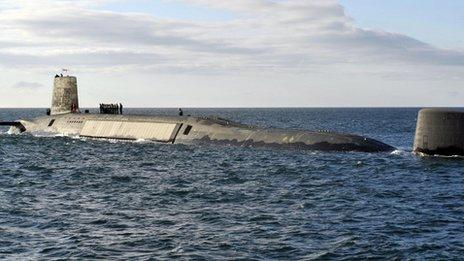Trident review: At-a-glance
- Published
The government has published a review, instigated by the Lib Dems, on "alternatives" to the Trident nuclear weapons system.
The UK's existing four ballistic missile submarines have to be renewed from the late 2020s and a final decision is due in 2016.
Here is a summary of the main points.
NUCLEAR DOCTRINE
Nuclear weapons will remain a "political tool of last resort" and be considered only "in the most extreme circumstances"
Their rationale is to deter extreme threats to the UK or to prevent an escalation that may risk "national survival"
The credibility of any weapons system is "crucial" but it must also be safe and secure and affordable
UK not able to conduct live tests of new warheads as signatory to Nuclear Test Ban Treaty
DELIVERY MECHANISMS
Modifying civilian aircraft to carry nuclear missiles "very high risk"
Stealth bomber expensive and would need support aircraft
Low orbit vehicles "too risky" for conversion to nuclear platforms
Mobile land-based missile launchers hard to protect and "operationally risky"
Missiles based at fixed silo locations "more vulnerable" to pre-emptive attack
Reconfiguring ballistic missile submarines to carry cruise missiles "discounted on cost grounds"
New "dual use" submarines could be built but fleet size would have to be expanded
MISSILES
Subsonic cruise missile potentially deliverable by 2035 despite technical challenges
Supersonic cruise missiles "vulnerable" as may have to be located too close to adversary
Hypersonic cruise missiles involve "extreme technical challenge" and multiplicity of platforms
Hyper glide vehicles too much of a "technical challenge"
Shorter range of cruise missiles could lead to "significant constraints" on UK options
Ballistic missiles could potentially target any country due to long range
WARHEADS
Cruise missile warhead twice as expensive as ballistic one - at up to £10bn
Length of time needed to develop cruise warhead and delivery system means two new ballistic submarines would have to be built in the interim to prevent a capability gap
POSTURES
Report distinguishes between high, medium and low readiness
Credibility based on readiness, reach, survivability and resolve
Only a fleet of four ballistic missile submarines and missiles housed in silos could provide 30-year continuous deterrent
For other platforms it would be "prohibitively expensive"
SUBMARINES
Cruise missile submarines more "vulnerable" to attack while on operations
Only a sophisticated adversary can "locate, track and engage" ballistic nuclear submarines
Three boats would not be sufficient to maintain continuous patrols and could lead to "multiple unplanned breaks"
Less regular patrols could be maintained with three or two boats based on Royal Navy priorities
INTERNATIONAL OBLIGATIONS
Any change may have wider implications for UK strategic interests
Reduced capability may increase reliance on allies for nuclear security
Cruise missile based system would be seen as "less capable" than a ballistic system
Increasing readiness from a non-continuous posture might lead to "misunderstanding"
Perceptions of the UK's commitment to multilateral nuclear disarmament may be increased
Any new system would have to comply with treaty obligations
COSTS
The reliability of estimates varies widely due to the long time period involved
Cruise missile platforms generally cheaper than ballistic ones
But added expenditure on missiles and warheads mean keeping ballistic submarines more cost-effective
Building three rather than four new Trident submarines would save money but only between 2025 and 2035
- Published23 May 2017
